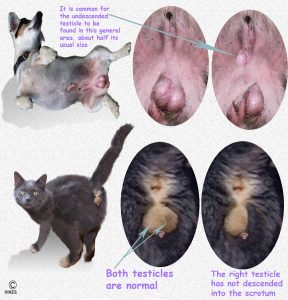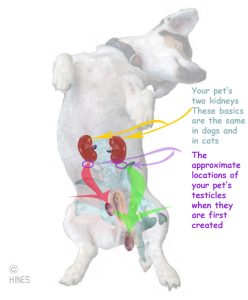Retained Testicle Or Cryptorchidism In Your Dog Or Your Cat
Ron Hines DVM PhD
What Is Cryptorchidism?
Cryptorchidism is a condition in which one or both of your dog or cat’s testicles fail to descend into its scrotum. It is a relatively common defect and, along with umbilical closure issues, are probably the most common birth defects that veterinarians encounter. It appears to occur a bit more commonly in purebred than random-bred (crossbred) dogs. I see about three dogs with this problem for every cat. That is probably because so many ordinary family cats in North America have a rich genetic pool. Inbreeding concentrates the bad as well as the good genes. Miniature schnauzers, cocker spaniels, chihuahuas, Persian and Siamese cats all have more than their fair share of cryptorchidism issues. But any breed or random-bred pet has the potential to be affected. On a molecular level, cryptorchidism appears to be due to a deficiency in a specific hormone, Anti-Müllerian hormone prior to birth.
Dog and cats in which both testicles fail to complete their normal journey from inside your pet’s abdomen into its scrotum are usually sterile. When testicles remain in a dog or cat’s abdomen, the 4-5 F/2.2-2.8 C degree higher temperature there usually prevents the production of viable sperm. That higher temperature does not, however, affect the testicle’s production of testosterone. hormone. So, those pets exhibit typical male behavior. When only one of your dog or cat’s testicles does not descend into its scrotum your pet should still be fertile. When two missing testicles are under the skin near the scrotum, your pet might still be fertile. But it is a very bad idea to breed dogs and cats that have any degree of cryptorchidism because their descendants all have the potential to carry the same defective genes.
Sertoli Cell Tumors:
Cryptorchid dogs and cats do have a higher rate of developing a certain hormone-secreting cancer call sertoli cell tumor. The sertoli cells are distributed within your pet’s testicles. They provide nourishment to your dog or cat’s sperm cells. Sertoli cells also produce feminizing hormones (estrogens). The higher body temperature within retained testicles is thought to be the reason why sertoli cell tumors form more frequently in cryptorchid dogs, cats and humans. When these tumors do form they often cause thinning of the skin, sparse hair coat, sometimes aplastic anemia, enlarged breasts and sexual attractiveness to other male dogs. Side effects are less characterized in male cats. The hair loss in these cases is very specific. It is identical on both sides of your pet’s body (bilaterally symmetrical). Your veterinarian might need to perform an ultrasound examinations of the retained testicle as well as a plasma estrogen level determination to confirm that a sertoli cell tumor exists.
Ten to twenty percent of these tumors are reported to be malignant. Therefore, they could metastasize (move) to other parts of the pet’s body. If the tumor has spread it can usually be treated successfully with chemotherapy. To avoid this debilitating treatment, your veterinarian will probably suggest that your pet’s cryptorchid testicle be located and surgically removed before it has an opportunity to spread. Many veterinarians would suggest that you let your dog or cat’s body fully mature before depriving it of the important androgens that testicles produce. Sertoli cell issues form over an extended period of time; so they are not an immediate issue in puppies or kittens.
Another problem that is much rarer, but could potentially occur in cryptorchid pets is a torsion (twisting) of the spermatic cord, the sperm duct that is attached to each testicle. Should that happen, the retained testicle loses its blood supply and becomes devitalized. I have never seen a case. But they have been reported.
What Are The Signs I Might See If My Dog Or Cat Is Cryptorchid?
I mentioned some of the long-term symptoms of cryptorchidism earlier. Cryptorchidism in dogs over twelve weeks of age is easy to see when the scrotal area of your pet is examined. It is a bit harder to detect in cats that young. An experienced person needs to only pass the scrotum through pinched fingers to notice that only one or neither of the testicles are present. The younger the pet, the smaller the testicles will be. So, examination of small puppies and kittens is best performed by an experienced individual.
In more than half of the cases, your veterinarian can palpate (locate with their fingers) your pet’s missing testicle(s) just forward of the scrotum, or in the fat located in the animal’s groin. In those case, testicles have been surgically relocated into the scrotum. Sometimes testosterone therapy is said to allow a retained testicle to descend fully into the scrotum when it did not quite make it there. Other veterinarians administered injections of chorionic gonadotropin (HCG) in an attempt to encourage the testicle(s) to descend. In humans, HCG injections were said to assist testicular descent 15-20% of the time. (read here) All that was before physicians and veterinarians were fully aware of the importance of Anti-Müllerian hormone. I do not feel that any of those procedures should ever be performed. Doing so or breeding your cryptorchid dog or cat assures the defect will occur in future generations of dogs and cats. Why would you want to take part in that? Instead, have your pet neutered so that both testicles are removed, and it cannot pass this defective trait on to future generations. If you did not intend to neuter your pet, have the undescended testicle removed to preserve your pet’s future health. Living with a sexually intact male cat is a challenge. But not every male dog needs to be neutered and none of them need to be neutered before they are sexually mature. You can read my thought on that here.
A special problem comes up when an adult dog or cat of either sex appears to have been castrated or spayed but still exhibits male or female sexual behavior. In those instances, veterinarians can be uncertain if they are dealing with a castrated male cat or dog with other health issues, a cryptorchid pet whose undescended testicle(s) was not located and removed, a pet with a hormone imbalance of some other kind or an ovary or ovarian remnant that was missed during spay surgery. In those cases, more tests need to be run. Sometimes the retained testicle can be visualized in the abdomen through ultrasound. When this is not the case, pet can be given an injection of chorionic gonadotropin. If this hormone causes a rise in serum testosterone level one hour after injection, we are most likely dealing with a cryptorchid pet. When this question occurs in a cat, we can examine its penis for spines. Penile spines are much smaller in fully castrated male cats than in cats that still have one or more hidden cryptorchid testicles.
Testicles migrate from the abdomen to your pet’s scrotum through two small windows in the groin called the inguinal rings. When the missing testicle or testicles have not passed through the inguinal rings and are still located in your pet’s abdomen, the surgery is much more complicated than when they have moved farther along on their journey toward the scrotum.
In those more difficult cases, your veterinarian must, in effect, neuter and “spay” at the same time. The missing testicle could be anywhere between the rear-most (posterior) pole (end) of your pet’s kidney and the inguinal ring on the same side as the missing testicle. It can be nerve-racking for your veterinarian to find and remove it. Particularly so if your pet is overweight. These retained testicles are much smaller and softer than normal descended ones and can be quite difficult to locate among the fat that occupies the posterior abdominal space (the retroperitoneal area). What usually allows them to be found is their epididymis or sperm collecting tubules that still retain their distinctive appearance and “bumpy” feel through your veterinary surgeon’s gloves.
Dogs and cats that are cryptorchid have a slightly higher incidence of other developmental defects such as inguinal and umbilical hernias, abnormally formed penises or sheaths and cleft palates. You can read more about some of those much more serious birth defects that occasionally occur in dogs and cats here.
Some authorities suggest waiting up to six months before deciding that the testicle(s) are not going to descend fully. I have never seen a case where the testicle(s) were not descended at twelve weeks of age but descended later. Late descent, during the first year of life, is common in people – but humans stand erect and gravity might helps move human testicles down.
You are on the Vetspace animal health website
Visiting the products that you see displayed on this website help pay the cost of keeping these articles on the Internet.


